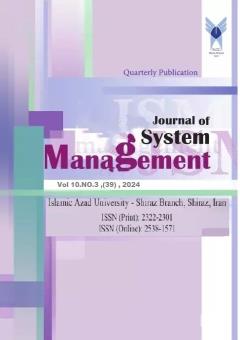Supply Chain Risk Management Analysis based on Resilience Capabilities (Comprehensive Structural Interpretive Modeling Approach)
محورهای موضوعی : Entrepreneurship and Innovation
Negin Sadri
1
![]() ,
Mahmoud Modiri
2
,
Kiamars Fathi Hafshjani
3
,
Changiz Valmohammadi
4
,
Mahmoud Modiri
2
,
Kiamars Fathi Hafshjani
3
,
Changiz Valmohammadi
4
1 - PhD Candidate, Department of Industrial Management, South Tehran Branch, Islamic Azad University, Tehran, Iran.
2 - Department of Industrial Management, South Tehran Branch, Islamic Azad University, Tehran, Iran
3 - Department of Industrial Management, South Tehran Branch, Islamic Azad University, Tehran, Iran
4 - Associate Professor, Department of Industrial Management, South Tehran Branch, Islamic Azad University, Tehran, Iran.
کلید واژه: Risk, Risk management, Supply chain, Resilience, Gasoline, Comprehensive Interpretive structural model.,
چکیده مقاله :
Since organizations work in complex and uncertain settings, their supply chains should be managed. The first step of supply chain management is to identify factors such as risks that disrupt this process. Risk and disruption can lead to failure of the supply chain of companies. Therefore, to reduce the effect of such disruption, the supply chain should be designed in such a way that they can recover to their initial state or even create better conditions by providing an efficient and effective response in the face of events. i.e., resilience in the structure of the supply network. Given the importance of risk management and resilience in the supply chain on the one hand, and few qualitative studies conducted in this field on the other hand, this study was conducted to propose a paradigmatic model of risk management based on resilience in the National Iranian Oil Products Distributing Company (NIOPDC) and the gasoline supply chain. This study has been conducted using a qualitative approach and multi-grounded theory (MGT) in such a way that with a deep review of the relevant literature and the use of 64 articles and 17 semi-structured interviews, data were collected and analyzed and a Conceptual Model of supply chain risk management (SCRM) was proposed by the resilience approach for gasoline products in the NIOPDC.Based on research findings, A total of 58 concepts and 14 dimensions were extracted under 5 categories of SCRM, a Conceptual Model was proposed, and accordingly two hypotheses were presented. Given the proposed paradigm model, risks cause disruption in the supply chain. If there is a governing platform for active supply risk management, by identifying risks and applying resilience capabilities to face the risks appropriately leads to management risks and achievement of the goal of "guaranteeing smooth and uninterrupted flow of fuel supply".
Since organizations work in complex and uncertain settings, their supply chains should be managed. The first step of supply chain management is to identify factors such as risks that disrupt this process. Risk and disruption can lead to failure of the supply chain of companies. Therefore, to reduce the effect of such disruption, the supply chain should be designed in such a way that they can recover to their initial state or even create better conditions by providing an efficient and effective response in the face of events. i.e., resilience in the structure of the supply network. Given the importance of risk management and resilience in the supply chain on the one hand, and few qualitative studies conducted in this field on the other hand, this study was conducted to propose a paradigmatic model of risk management based on resilience in the National Iranian Oil Products Distributing Company (NIOPDC) and the gasoline supply chain. This study has been conducted using a qualitative approach and multi-grounded theory (MGT) in such a way that with a deep review of the relevant literature and the use of 64 articles and 17 semi-structured interviews, data were collected and analyzed and a Conceptual Model of supply chain risk management (SCRM) was proposed by the resilience approach for gasoline products in the NIOPDC.Based on research findings, A total of 58 concepts and 14 dimensions were extracted under 5 categories of SCRM, a Conceptual Model was proposed, and accordingly two hypotheses were presented. Given the proposed paradigm model, risks cause disruption in the supply chain. If there is a governing platform for active supply risk management, by identifying risks and applying resilience capabilities to face the risks appropriately leads to management risks and achievement of the goal of "guaranteeing smooth and uninterrupted flow of fuel supply".


